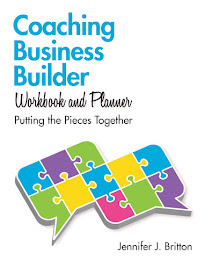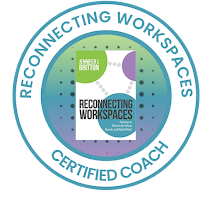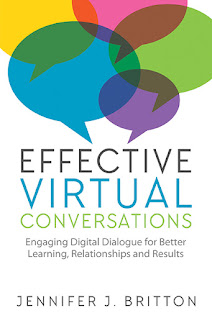Group Facilitation Tip - Co-Facilitation
Copyright 2007 - Jennifer Britton
This week's group facilitation tip is on co-facilitation. A major theme for me this year is around collaboration, and a number of really significant opportunities have presented themselves in the last few months. In my mind, co-faciltiation enhances the possibilities and outcomes of group programs, ensuring that in my work and others that the "sum is greater than it's parts".
For many years I was involved in co-facilitation when I ran retreat programs for organizations. It was often quite common to have 250 or more staff in the room, and we needed 2 or 3 facilitators. After several years of often running programs on my own, I'm back to the world of co-faciliation and I am loving it. As a relationship systems coach most of our large group work is done through co-facilitation when working with teams.
I often get asked " What are some tips for co-faciltiation?" I would love to have a magic bullet, but unfortunately I don't. I have seen, and experienced when co-facilitation has gone well, and also when things have run amok, leaving a sour taste for everyone involved.
Here are a couple of things to keep in mind when designing your next co-facilitation:
1. What are your strengths? Your passions? Your weaknesses? Creating the opportunity for each person to leverage their strengths and passions leads to more fun, creativity and presence. What are you good at? What do you like to do?
2. How are you complimentary? Many successful partnerships and the business world are based on complimentary skills -- how do you each compliment each other? I have seen excellent facilitators come together to co-facilitate, and the program has fallen flat, in part due to the similar nature of each one. If you are working with someone who is very much like yourself, what do you need to be aware of? How can you bring in the complimentary skills you need?
3. Clearly define your roles. Masterful co-facilitation is like a dance. Who is taking the lead? Things get murky when roles are not clear. I spend a lot of time up front with my co-facilitator, even before the start of a program, designing what our roles are going to be. Who will take a lead on this part of the program? Who is going to be responsibile for that? Spending time to build this foundation allows us to look at where do we synergize, and who takes the lead at different stages.
4. What are your expectations for the program and your partnership? Spend time before the program discussing your expectations for the program and your partnerhip. A disconnect between each parties expectations can lead to conflict and that sour taste in your mouth.
Ask each other "What are your hopes, fears and fantasies for the program and the partnership?".
I would love to hear about your experience with co-facilitation - the highs and the lows. What made it work really well? What stopped it in its tracks? Please feel free to comment below.
With best wishes,
Jennifer
Jennifer Britton, CPCC, CHRP, CPT
Potentials Realized ~ Group Coaching Essentials
Toll Free: 1-866-217-1960
Email: jennifer@potentialsrealized.com
Wednesday, March 28, 2007
Tuesday, March 20, 2007
Group Facilitation Tip - Stages of Group Formation
Group Facilitation Tip - Stages of Group Formation
Copyright 2007 - Jennifer Britton
This week's tip is about the basic building blocks of group formation - those stages a group goes through in its development. In 1965, Bruce Tuckman developed a four stage process of group development -- forming, storming, norming and performing. He later added a fifth stage - adjourning - which groups go through at the end of an intensive group process, such as an intensive retreat, the closure of a project, or the end of an intensive group coaching program. Another label for the adjourning stage is mourning. Some groups move into the transforming stage should the group continue to work together (hence the word transformational leadership/management).
Each stage has its own unique characteristics, signalling the need for different types of facilitation support during each stage.
There are a number of great articles on the stages of group formation online including:
* Wikipedia
*Infed's look at Bruce Tuckman's stages
*12Manage (Rigor and Relevance in Management)
There is also an interesting chart outlining the stages of group development and suggested activities for group facilitators from the 1st Annual Caribbean HIV and Development Workshop, Barbados (1999). Different labels than Tuckman's five stages but it provides really clear ideas on how to support groups in the different stages.
I'll be following up in future posts with a more in depth look at each stage of the group process cycle. The one that I feel is most overlooked is the adjourning stage - what happens at the end of a program. If you haven't read my blog post last summer on the Importance of Closure and some activities you can introduce at this stage, please feel free to take a look. I'm sure there are some ideas you will find useful.
What questions do you have about the stages of group formation? Do you see your groups go through a similar process? How do you support them at each stage? What tools do you want more of for each stage? I'd welcome your comments -- please feel free to post them below.
Jennifer
Jennifer Britton, CPCC, CHRP, CPT
Potentials Realized ~ Group Coaching Essentials
Email: jennifer[at]potentialsrealized[dot]com
Copyright 2007 - Jennifer Britton
This week's tip is about the basic building blocks of group formation - those stages a group goes through in its development. In 1965, Bruce Tuckman developed a four stage process of group development -- forming, storming, norming and performing. He later added a fifth stage - adjourning - which groups go through at the end of an intensive group process, such as an intensive retreat, the closure of a project, or the end of an intensive group coaching program. Another label for the adjourning stage is mourning. Some groups move into the transforming stage should the group continue to work together (hence the word transformational leadership/management).
Each stage has its own unique characteristics, signalling the need for different types of facilitation support during each stage.
There are a number of great articles on the stages of group formation online including:
* Wikipedia
*Infed's look at Bruce Tuckman's stages
*12Manage (Rigor and Relevance in Management)
There is also an interesting chart outlining the stages of group development and suggested activities for group facilitators from the 1st Annual Caribbean HIV and Development Workshop, Barbados (1999). Different labels than Tuckman's five stages but it provides really clear ideas on how to support groups in the different stages.
I'll be following up in future posts with a more in depth look at each stage of the group process cycle. The one that I feel is most overlooked is the adjourning stage - what happens at the end of a program. If you haven't read my blog post last summer on the Importance of Closure and some activities you can introduce at this stage, please feel free to take a look. I'm sure there are some ideas you will find useful.
What questions do you have about the stages of group formation? Do you see your groups go through a similar process? How do you support them at each stage? What tools do you want more of for each stage? I'd welcome your comments -- please feel free to post them below.
Jennifer
Jennifer Britton, CPCC, CHRP, CPT
Potentials Realized ~ Group Coaching Essentials
Email: jennifer[at]potentialsrealized[dot]com
Sunday, March 11, 2007
Group Facilitation Tip - Create a Safe Space
Group Facilitation Tip - Create a Safe Space
Copyright 2007 - Jennifer Britton, CPCC, CHRP. All Rights Reserved.
This week's Group Facilitation Tip is about creating a safe space for your group program - be it a workshop, retreat or group coaching session.
Creating a safe space means a couple of really important things for me. First, confidentiality. Confidentiality is extremely important in any group coaching program, and even more so when colleagues work together, or participants all live in the same small community. Often personal information is divulged within a retreat or group coaching session that might not be shared in a regular group environment. As part of creating "ways of working" with each of my groups at the start of the program, I include confidentiality as part of our ground rules, and ask the group what confidentiality means for them.
Group programs can provide the opportunity for participants to stretch and explore areas of their life or work they might not go otherwise. As a faciltiator, it is important to recognize that each person's "stretch" points are going to look very different. What may appear easy for one person, will be a huge stretch outside another person's comfort zone. Getting to know your participants, their needs and their comfort zones prior to the program, or at the start of a program, will enable you to support them most effectively. Ask yourself if you are checking in individually or as a group with members throughout a program (particularly if the program is long or multi-sessioned).
A third way I like to create a safe space for my participants is to ensure that I am transparent with the process. Wherever possible, I like to co-design programs with participants needs in mind, based on pre-session meetings (needs assessments). When contracted as an external facilitator I also spend time discussing with the sponsor their expectations for my role, as well as my philosophy of being an external "neutral" third party, with no other agenda than that for the success of the group.
How else do you create a "safe" space for your participants? What do you do to ensure they can stretch, explore and learn the most? I'd love to hear your comments -- so please feel free to comment below.
With best wishes,
Jennifer
Jennifer Britton, CHRP, CPCC, CPT
Group Coaching Essentials ~ Potentials Realized
email: jennifer[at]potentialsrealized[dot]com
This month's Group Coaching Essentials program is full to capacity! I am now starting to accept registrations for April's program which will start on April 10th (Tuesdays 10:45 - 12 noon EST ). Our group calls will be held April 10, 17, May 1 and 8th (with a fifth call scheduled for June). If you are looking to create and launch your own group coaching program this spring, consider joining me and 7 other coaches for this program. It is a hands-on, intensive teleseminar program, focusing on the design, implementation and marketing of your own group coaching program. You'll leave the program with a new toolbox bursting with exercises, marketing ideas, templates and other resources. Space is limited to 8, so email me to reserve your spot for April. I look forward to having you join me!
Copyright 2007 - Jennifer Britton, CPCC, CHRP. All Rights Reserved.
This week's Group Facilitation Tip is about creating a safe space for your group program - be it a workshop, retreat or group coaching session.
Creating a safe space means a couple of really important things for me. First, confidentiality. Confidentiality is extremely important in any group coaching program, and even more so when colleagues work together, or participants all live in the same small community. Often personal information is divulged within a retreat or group coaching session that might not be shared in a regular group environment. As part of creating "ways of working" with each of my groups at the start of the program, I include confidentiality as part of our ground rules, and ask the group what confidentiality means for them.
Group programs can provide the opportunity for participants to stretch and explore areas of their life or work they might not go otherwise. As a faciltiator, it is important to recognize that each person's "stretch" points are going to look very different. What may appear easy for one person, will be a huge stretch outside another person's comfort zone. Getting to know your participants, their needs and their comfort zones prior to the program, or at the start of a program, will enable you to support them most effectively. Ask yourself if you are checking in individually or as a group with members throughout a program (particularly if the program is long or multi-sessioned).
A third way I like to create a safe space for my participants is to ensure that I am transparent with the process. Wherever possible, I like to co-design programs with participants needs in mind, based on pre-session meetings (needs assessments). When contracted as an external facilitator I also spend time discussing with the sponsor their expectations for my role, as well as my philosophy of being an external "neutral" third party, with no other agenda than that for the success of the group.
How else do you create a "safe" space for your participants? What do you do to ensure they can stretch, explore and learn the most? I'd love to hear your comments -- so please feel free to comment below.
With best wishes,
Jennifer
Jennifer Britton, CHRP, CPCC, CPT
Group Coaching Essentials ~ Potentials Realized
email: jennifer[at]potentialsrealized[dot]com
This month's Group Coaching Essentials program is full to capacity! I am now starting to accept registrations for April's program which will start on April 10th (Tuesdays 10:45 - 12 noon EST ). Our group calls will be held April 10, 17, May 1 and 8th (with a fifth call scheduled for June). If you are looking to create and launch your own group coaching program this spring, consider joining me and 7 other coaches for this program. It is a hands-on, intensive teleseminar program, focusing on the design, implementation and marketing of your own group coaching program. You'll leave the program with a new toolbox bursting with exercises, marketing ideas, templates and other resources. Space is limited to 8, so email me to reserve your spot for April. I look forward to having you join me!
Saturday, March 03, 2007
Group Facilitation Tip - Create the Environment
I received an email this week which has spurred me on to start offering a weekly group facilitation tip as part of my blog. These tips will be useful for anyone who is undertaking any sort of group facilitation, whether it is coaching, training or retreat work. I hope that you enjoy and continue to take away some golden nuggets.
Group Facilitation Tip #1 - Create the Environment
Copyright 2007 - Jennifer Britton
The environment you hold your group programs in can have an incredible impact on the group's experience. Take a moment and think about your most powerful learning experience -- what was the setting of this? Now take a moment and think about one of the most disasterous learning experiences you have had -- how did the environment play into this?
What's the environment you want to create for your program? Take a few mintues and write this down.
The actual location of a program will have a powerful impact on the participant's experience. This blog post and others will explore different aspects of creating the environment for your group program. Today we'll focus on the primary area of room, or location set-up.
If you are holding your program indoors....
* What is the room set up like? How does this match your program's objectives?
* Can tables/chairs/furniture be moved as your program progresses to allow for small group work/large group work/individual work?
* Is there natural lighting? Even having one window available can make a difference.
* What's the room temperature like? How is it controlled?
* Is there sufficient room for the number of participants?
* Is there space to lay out resources, books, information about upcoming programs?
* If you are offering snacks, water or other beverages, where are these located?
If you are holding your program outdoors....
* How can you make use of the entire surroundings? Prehaps you can run exercises in different areas.
* What's your back-up plan in case of a change in weather?
* Where is shade available? Sunlight available? (Having run programs in the tropics for many years I am quite sensitive to finding the shady areas!)
* What will the balance be between indoors and outdoors work.
These are just a few considerations when looking at running your next group program. Take some time to envision what the environment will be like for your participants -- what is the space you want to create?
With best wishes,
Jennifer
Jennifer Britton, CPCC, CHRP, CPT
Potentials Realized.com
GroupCoachingEssentials.com
Email: jennifer[at]potentialsrealized[dot]com
Toll Free: 1-866-217-1960
Group Facilitation Tip #1 - Create the Environment
Copyright 2007 - Jennifer Britton
The environment you hold your group programs in can have an incredible impact on the group's experience. Take a moment and think about your most powerful learning experience -- what was the setting of this? Now take a moment and think about one of the most disasterous learning experiences you have had -- how did the environment play into this?
What's the environment you want to create for your program? Take a few mintues and write this down.
The actual location of a program will have a powerful impact on the participant's experience. This blog post and others will explore different aspects of creating the environment for your group program. Today we'll focus on the primary area of room, or location set-up.
If you are holding your program indoors....
* What is the room set up like? How does this match your program's objectives?
* Can tables/chairs/furniture be moved as your program progresses to allow for small group work/large group work/individual work?
* Is there natural lighting? Even having one window available can make a difference.
* What's the room temperature like? How is it controlled?
* Is there sufficient room for the number of participants?
* Is there space to lay out resources, books, information about upcoming programs?
* If you are offering snacks, water or other beverages, where are these located?
If you are holding your program outdoors....
* How can you make use of the entire surroundings? Prehaps you can run exercises in different areas.
* What's your back-up plan in case of a change in weather?
* Where is shade available? Sunlight available? (Having run programs in the tropics for many years I am quite sensitive to finding the shady areas!)
* What will the balance be between indoors and outdoors work.
These are just a few considerations when looking at running your next group program. Take some time to envision what the environment will be like for your participants -- what is the space you want to create?
With best wishes,
Jennifer
Jennifer Britton, CPCC, CHRP, CPT
Potentials Realized.com
GroupCoachingEssentials.com
Email: jennifer[at]potentialsrealized[dot]com
Toll Free: 1-866-217-1960
Subscribe to:
Posts (Atom)











